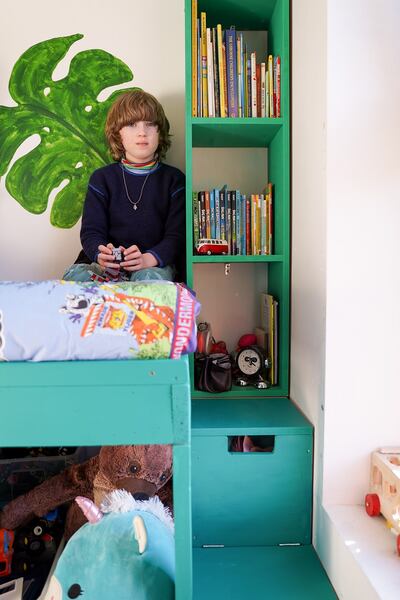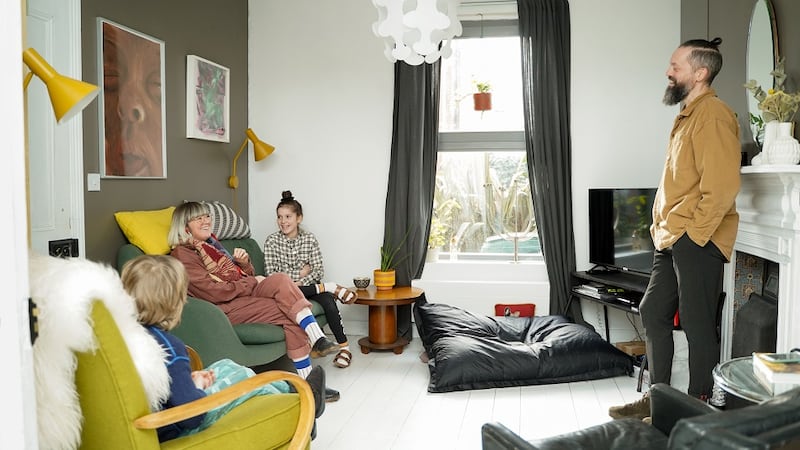Vegetarians since their mid-teens, Trevor and Irenie Bacon, a visual artist and conservation architect living in Dublin 8, both have a strong sense of being environmentally conscious. When they started their family it was inevitable that their kids would follow suit.
In fact, it was having children that made them more determined than ever to do their best when it comes to caring for the planet, Irenie says. But it’s not always an easy journey.
“We found feeding the family was becoming more difficult as the expense of buying organic produce or shopping in the food co-op or health stores wasn’t always possible or convenient,” she says. “So we’ve learned to shop very mindfully no matter what, ensuring we buy loose fruit and vegetables, lessening the waste from packaging or buying organic.”
While there can be savings to be gained overall by becoming more environmentally friendly, these can be offset by paying more for particular items. Eco-friendly and reusable products are now more readily available, but natural products using sustainable packaging can still be a lot more expensive, Irenie explains.
“Plant-based foodstuffs, milk and other products have become less expensive. Buying seasonal vegetables and loose foodstuff and refilling bottles for washing up liquid and cleaning products does save money,” she says.
Food waste is a big issue for a lot of families and the Bacons try to tackle this by making one pot meals that can be used another day or adapted as part of a different meal.
As a family they consider what they recycle, and try and stop producing that waste in the first instance. “We switched to using bars of natural soap and stopped buying Clingfilm years ago as you can store leftovers in jars or other containers you already have or by simply putting a plate over the top,” Irenie explains. “When there is an option, we prefer to buy foodstuffs like rice, cereal and pasta from places where you bring your own container and get what you need.”
Cosmetics and toiletries also produce a lot of plastic waste, she says. “Little changes like ear buds made from paper, cotton tooth floss, natural products, shampoo bars and skincare in glass jars and which has no unnecessary packaging is how we’ve tried to tackle this.”

As an artist producing sustainable visual art, Trevor reuses offcuts of timber or other materials that would otherwise be discarded. He’s brought this to bear in the couple’s stylish home.
“We will always try to find a new use for furniture or other household items if we can’t pass them on or give them to charity,” he says. “Our work-from-home desk is made from reused timber along with other items in our home, including the kids’ bed frames and storage, all made using offcuts of timber, discarded materials or by repurposing furniture we already had.”
Irene points out that there doesn’t need to be any aesthetic compromise either. “We are both very design-led within our home environment given our careers and backgrounds and I feel that the love of design doesn’t have to be compromised while being eco-friendlier and more sustainable. Repurposing things you already have to find a new use is a clear winner, and it helps having someone very handy in the house for this,” she laughs.

For eight-year-old son Jasper, it’s a win-win. “I don’t want any more sea life to die because people are using so much plastic and throwing it away. I love my bedroom as daddy built it reusing old drawers and wood that could have been thrown away,” he says.
Daughter Marla-Tait (11), is involved too. “I think it’s really important we do everything we can so the planet can keep living and keep going for everyone into the future. We all need to be responsible and not rely on others. I’m inspired by Greta Thunberg. I attended the Climate Change protests and it’s a very important issue that is not being seen as the crisis it should be,” she says.
Both children became very aware of carbon footprints after watching a documentary about climate change. “Jasper had nightmares and I had to reassure him that all the small things we are doing as a family, together with everyone else who is doing their bit, will all make a difference,” Irenie says.
Reuse, re-wear

As a fashion fan, people often assume Irenie buys a lot of clothes. In fact, this is another way she has brought sustainability to bear in her day-to-day. She purchases only a handful of items each year and mixes and matches to keep her outfits fresh.
I buy items that I know will last and therefore will pay what they are worth
“I have clothes I’ve worn over the past 10 years, which have stood the test of time and I’ll continue to wear them,” she says. “The concept of no clothes 365 or a 30 wears challenge certainly gets people thinking twice before parting with cash and adding to an already extensive wardrobe – it’s too easy to buy online and buy every season. I buy items that I know will last and therefore will pay what they are worth.”

During the first lockdown Marla-Tait attended an eco-Unesco Zoom workshop where older kids were shown how to make a face mask using worn-out or unwanted fabric. She has also started making hair scrunchies with old clothes fabric – a hit with her friends.
“Repurposing clothes is also a great way of reusing what you already have and giving it a new lease of life. Little things like Jasper’s leggings getting cut up for summer shorts, for example,” Irenie explains.
“We have opted to dry our clothes on the line and have included a drying area in the house when the weather is bad instead of using a tumble dryer,” she says.
Future perfect

In the past couple of years the couple has started thinking about bigger changes in terms of reducing their reliance on fossil fuels and identifying what other areas they can start working on together as a family.
“This year we are going to look into using our extension roof to grow more fruit and vegetables as last year we ran out of space in the garden, a problem for most families living in the city. During the first lockdown we made changes to our small back garden to make it better for the kids; some planting and we introduced some small trees,” she says.
For Jasper, it’s a learning experience. “I love seeing how all food scraps and waste becomes soil for planting and growing things,” he says.
Irenie says that while the journey can sometimes be overwhelming, ultimately it is worthwhile. “It isn’t always an easy thing to do, but it is simply about making small changes,” she says.
“It’s not just about reducing your carbon footprint, but also about your wellbeing and knowing that you are being conscious in your decision making and making the effort to follow through on things that do make a difference, in a small but incremental way, and not just doing it because it is on trend.”
Adventure awaits in the all-new ID.4

The new ID.4, a family-friendly all-electric SUV from Volkswagen, is now available in Ireland. Available in nine versions with ranges from 341-519km**, there are two battery sizes available (52kWh and 77kWh). Volkswagen is Ireland’s best-selling electric car (BEV) brand***, so it knows a thing or two about what makes for a great electric car.
The 4.58 metre-long ID.4 sits on Volkswagen’s modular electric drive matrix (MEB) platform and offers leg- and headroom similar to Volkswagen’s Tiguan Allspace SUV. The battery is located under the passenger compartment, ensuring a low centre of gravity, increased space in the interior cabin and balanced distribution of the axle load. This gives the car excellent, sporty handling and the 16cm ground clearance allows the vehicle to cope with light off-road terrain.
The ID.4 boasts many great features such as the LED Matrix IQ-Light system, Travel Assist, Area View and the Augmented Reality Head-up Display, first introduced on the ID.3, projects important information onto the windscreen, separating this data into two display areas – a world first.
Discover more about the all-new ID.4 on volkswagen.ie/ID4
*** SIMI figures as of 11th March 2021










